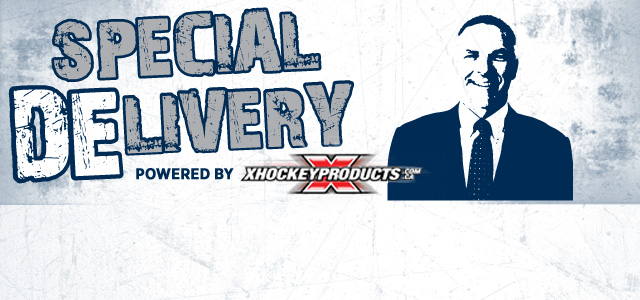Special DElivery: “He had his head down” no longer applies

By Darren Eliot –
The changing culture of hitting in the NHL continues to evolve before our very eyes. From “picking the head”, to “the head as the principal point of contact”, to “significant head contact” to what we’re witnessing in these NHL playoffs. If you take the interference hit by Eric Gryba of the Ottawa Senators, charging hit by Justin Abdelkader of the Detroit Red Wings and the boarding call in overtime by Daniel Sedin of the Vancouver Canucks, you have a snapshot of how things have changed.
Both Gryba and Abdelkader received two-game suspensions and Sedin’s penalty led to a power-play goal by the San Jose Sharks to clinch the series win. Suspensions and calls in overtime in crucial situations have long been meted out sparingly. That is no longer the case, as the NHL – much like the NFL – moves player safety issues to the top of the priority list. Both sports have physical play at the center of competition, with violent collisions as a routine possibility. The NFL has long put the burden of discretion on the defender by restricting hits in certain situations.
Hockey history has always put the burden of awareness on the offensive player, not the player without the puck. Playing with your head up is necessary to make plays to teammates, but also to account for defenders in position to disrupt a play with physical force. Clearly, with the calls on the ice and the supplemental discipline handed down from the NHL offices, the paradigm is shifting in our game.
The player in position to deliver a check now has the burden of discretion.
Taking advantage of an unsuspecting opponent is no longer explained away by “that was a suicide pass”, or “he had his head down” and “he should have braced for the hit”.
Those explanations or views were all trotted out in analyzing and debating the three earlier examples. They are now archaic. The vulnerable player is no longer at fault. It is up to the player bearing down to use discretion and control the violent nature of the potential contact. This all stems from the societal concern over concussions and head trauma sustained in sports. Thus, the NHL is looking to eliminate injuries by adding an element of control in the fastest and at times most chaotic playing environment in all of sports. It is why the outcome – a player being injured – factors greatly in supplemental reviews.
Even if this shift in responsibility seems radical, it makes sense. In the “keep your head up” era, offenses were faster than defenses. Back-checking meant you paced yourself back to your zone, as in “I’ve go my guy”. It wasn’t the furious footrace back to your zone to defend as a unit of five like it is today. Add in that today’s players skate better – top to bottom of every roster – and that the athletes are bigger, stronger and supremely conditioned and we now have defenses that play faster than the offense. This increases the potential for devastating hits exponentially over time.
The result is that the onus for a safe environment now falls on the faster side, the players without the puck – the defenders. The puck-optional “blowing a guy up” hit is too risky for a league trying to promote speed and skill on the offensive side of the game, while keeping the playing environment safe to create. It cannot be viewed as it was. Like turning your back to protect the puck along the boards – once a hockey no-no, now an every shift “puck-possession” strategy – strategies change and so to must attitudes.
With change, especially a cultural shift of this magnitude, comes shades of gray. One aspect that the NHL needs to look at to clear up the gray is having the checking player make his first move to the puck with his stick. Contact would then be delivered lower and through the puck carrier. By splitting the attention of the checking player, the potential violence of a collision would be mitigated by allowing the puck carrier a moment to recognize the situation, brace, protect the puck and engage in a one-on-one battle.
After all, in every era, that is what the game comes down to.


Pingback:URL